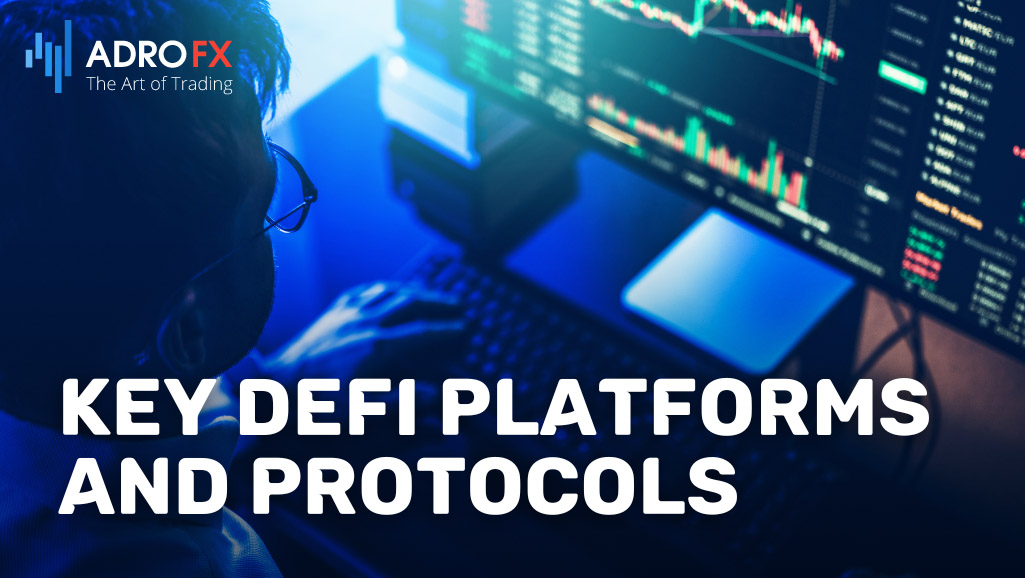From Banks to Blockchain: The Evolution of Decentralized Finance (DeFi)

Decentralized Finance (DeFi) represents a groundbreaking financial ecosystem operating independently of traditional intermediaries like banks and financial institutions. By leveraging blockchain technology, DeFi establishes a more accessible, transparent, and inclusive financial system, enabling individuals to directly participate in activities such as lending, borrowing, trading, and investing through decentralized platforms.
The significance of DeFi in today’s financial landscape cannot be overstated. While traditional finance grapples with inefficiencies, high costs, and limited accessibility, DeFi provides a compelling alternative. Its rapid expansion and adoption are reshaping financial transactions, democratizing access to services, and catalyzing innovation.
This article aims to explore the concept of DeFi comprehensively, delve into its foundational principles, and emphasize the diverse trading opportunities it offers. By gaining a deep understanding of DeFi's intricacies, traders and investors can navigate this emerging sector adeptly and capitalize on its vast potential.
Understanding Decentralized Finance
Decentralized Finance, abbreviated as DeFi, encompasses a wide array of financial services and applications built on decentralized blockchain networks. Unlike conventional financial systems that depend on centralized entities like banks and exchanges, DeFi employs smart contracts on blockchains to automate and verify transactions seamlessly.
At its core, DeFi embodies several key principles:
- Decentralization
DeFi operates on blockchain technology, ensuring that no single entity controls the entire system, thereby enhancing transparency and security. - Permissionless Access
Participation in DeFi activities is open to anyone with internet access, eliminating the need for approval from a central authority. - Transparency
All transactions and smart contract code are publicly accessible on the blockchain, ensuring complete transparency and auditability. - Interoperability
DeFi platforms and protocols can interact seamlessly with each other, fostering a unified financial ecosystem. - Censorship Resistance
Being decentralized, DeFi is less vulnerable to censorship or interference from centralized entities or governments.
In contrast, traditional finance, or centralized finance (CeFi), relies heavily on intermediaries such as banks, brokers, and clearinghouses to facilitate transactions. These intermediaries introduce complexity, increase costs, and restrict access to financial services. DeFi eliminates these intermediaries, facilitating peer-to-peer interactions and reducing reliance on centralized trust.
This transformational shift towards decentralized finance underscores its potential to redefine global financial systems, offering greater efficiency, accessibility, and innovation while challenging traditional norms.

Key DeFi Platforms and Protocols
Decentralized Finance operates on various blockchain platforms, each offering unique features and capabilities. Here, we highlight some of the major DeFi platforms and notable protocols within the ecosystem.
Ethereum functions through a proof-of-stake consensus mechanism, transitioning from proof-of-work, and operates smart contracts that execute decentralized applications (dApps). These smart contracts are coded in Solidity and deployed on the Ethereum blockchain.
Binance Smart Chain utilizes a proof-of-staked-authority (PoSA) consensus mechanism, combining aspects of proof-of-stake and proof-of-authority. It supports Ethereum Virtual Machine (EVM) compatibility, facilitating seamless migration of Ethereum dApps to its platform.
Polygon operates as an Ethereum sidechain, processing transactions off-chain and finalizing them on the Ethereum mainnet to alleviate network congestion and reduce transaction fees.
Uniswap functions by allowing users to provide liquidity to pools by depositing pairs of tokens. The protocol enables token swaps by adjusting prices automatically based on the ratio of tokens in the pool, using a constant product formula.
Aave and Compound operate by allowing users to deposit assets into liquidity pools, which are then available for borrowing by other users. Borrowers provide collateral, and interest rates are algorithmically set based on prevailing market conditions.
Advantages of DeFi
DeFi offers several significant advantages over traditional financial systems, making it an appealing alternative for many users.
Accessibility and Inclusivity
DeFi platforms are open to anyone with an internet connection, eliminating barriers such as geographical location, credit history, and banking access. This inclusivity democratizes financial services, enabling underserved and unbanked populations to participate in the global economy.
Transparency and Security
All transactions on DeFi platforms are recorded on public blockchains, ensuring transparency and accountability. Smart contracts, which execute automatically based on predefined conditions, reduce the risk of human error and fraud. Additionally, the decentralized nature of DeFi minimizes the risk of single points of failure.
Reduced Costs and Fees
By removing intermediaries, DeFi significantly lowers transaction costs and fees. Users can engage in financial activities such as trading, lending, and borrowing without incurring the high costs typically associated with traditional financial institutions.
Innovation and Flexibility
DeFi fosters a culture of innovation, with developers continuously creating new financial products and services. The modularity and interoperability of DeFi protocols allow for the creation of complex financial instruments and applications, providing users with a wide range of options and flexibility.

Risks and Challenges in DeFi
Despite its advantages, DeFi also presents several risks and challenges that users must consider.
Security Vulnerabilities and Smart Contract Risks
Smart contracts, while powerful, are not infallible. Bugs and vulnerabilities in smart contract code can be exploited by malicious actors, leading to significant financial losses. The immutability of blockchain transactions means that errors or hacks are often irreversible.
Regulatory Uncertainties
The regulatory landscape for DeFi is still evolving. Regulatory frameworks vary widely across jurisdictions, and the decentralized nature of DeFi makes it challenging to apply traditional regulatory measures. This uncertainty can pose risks for both developers and users.
Market Volatility
The cryptocurrency market is known for its high volatility, which can lead to significant fluctuations in the value of assets within DeFi protocols. Users must be prepared for the potential risks associated with market swings.
Liquidity Issues and Risks of New Technologies
New and emerging DeFi projects may face liquidity challenges, making it difficult for users to execute large trades or withdraw funds quickly. Additionally, the experimental nature of DeFi means that new technologies and protocols may have unforeseen risks or limitations.
By understanding these risks and challenges, users can make informed decisions and navigate the DeFi landscape more effectively, maximizing the opportunities it offers while minimizing potential pitfalls.
Trading Opportunities in DeFi
Decentralized Finance (DeFi) offers a wide array of trading opportunities that leverage the transparency and security of blockchain technology. This section explores key trading avenues within DeFi, focusing on decentralized exchanges (DEXs), yield farming, staking, lending, borrowing, and synthetic assets.
Decentralized Exchanges (DEXs)
Decentralized exchanges (DEXs) facilitate direct peer-to-peer trading of cryptocurrencies without intermediaries. Platforms like Uniswap and Sushiswap employ automated market maker (AMM) models, allowing users to securely trade tokens directly from their wallets. While DEXs provide control over funds and reduce hacking risks compared to centralized exchanges, they may present challenges such as liquidity issues and complexity for new users.
Yield Farming and Staking
Yield farming involves providing liquidity to DeFi protocols to earn rewards, often in native tokens. This method can yield high returns but carries risks such as impermanent loss and market volatility. Staking, on the other hand, entails locking cryptocurrencies to support blockchain networks and receiving rewards for network security and validation. Ethereum 2.0 and Cardano are notable platforms for staking, offering opportunities for passive income generation.
Lending and Borrowing
DeFi lending and borrowing platforms like Aave and Compound enable users to lend their cryptocurrencies to earn interest or borrow assets by collateralizing their holdings. These platforms offer flexibility and competitive interest rates compared to traditional financial institutions, although they come with risks such as smart contract vulnerabilities and fluctuating interest rates.
Synthetic Assets and Derivatives
Synthetic assets in DeFi represent real-world assets using blockchain technology, providing exposure to traditional financial instruments like commodities and stocks. Platforms such as Synthetix offer trading opportunities for synthetic assets, though investors must navigate risks such as liquidity issues and potential regulatory uncertainties.

Strategies for Successful DeFi Trading
Achieving success in DeFi trading requires strategic planning, rigorous risk management, and staying informed about market trends. Key strategies include:
- Diversification of Assets and Strategies
Spread investments across different DeFi protocols, tokens, and sectors to mitigate risks associated with market volatility. - Rigorous Risk Management
Establish clear entry and exit points based on thorough analysis. Use stop-loss and take-profit orders to safeguard investments and secure profits. - Stay Informed about DeFi Trends
Monitor developments, upgrades, and news within the DeFi ecosystem to anticipate market movements and make informed trading decisions. - Utilize Technical Analysis
Apply technical analysis tools to identify trends, support, and resistance levels in DeFi tokens and platforms. - Leverage Security Best Practices
Protect assets with robust security measures such as hardware wallets and thorough due diligence on projects and platforms. - Adaptability and Flexibility
Remain adaptable to market changes, regulatory shifts, and technological advancements to capitalize on emerging opportunities and mitigate risks effectively.
By integrating these strategies into your DeFi trading approach, you can enhance your ability to navigate the dynamic decentralized finance landscape and optimize trading outcomes.
Future of DeFi and Its Impact on Traditional Finance
The future of Decentralized Finance holds significant promise to transform traditional financial systems in profound ways. One of the most notable impacts lies in its potential to enhance accessibility and promote financial inclusion worldwide. DeFi eliminates barriers to financial services, offering individuals globally the opportunity to engage in lending, borrowing, trading, and other financial activities without relying on traditional banking intermediaries.
Moreover, DeFi fosters a fertile ground for continuous innovation in financial products and services. This innovation spans decentralized lending platforms, automated market makers, synthetic assets, and more. These advancements not only provide alternatives to conventional financial instruments but also improve operational efficiency, transparency, and accessibility for users.
Another critical aspect of DeFi's future lies in its ability to reduce costs and streamline processes by removing intermediaries like banks and financial institutions. Through the use of smart contracts and blockchain technology, DeFi automates processes that historically required manual intervention, thereby lowering transaction costs and speeding up transaction times.
Looking ahead, the integration of DeFi with traditional finance systems is a significant area of exploration. This integration could involve collaboration between DeFi protocols and regulated financial entities to leverage respective strengths while addressing regulatory compliance and risk management concerns.
However, the evolving regulatory landscape presents challenges. Regulatory clarity and frameworks will be pivotal in fostering DeFi's growth while ensuring consumer protection and market integrity. DeFi projects and platforms must navigate these regulatory considerations to achieve widespread adoption and long-term sustainability.
All in all, the future of DeFi holds promise for reshaping financial systems globally by enhancing accessibility, driving innovation, reducing costs, integrating with traditional finance, and navigating regulatory challenges. As DeFi continues to evolve, its impact on traditional finance will likely become more pronounced, influencing the financial landscape for years to come.
Conclusion
In conclusion, Decentralized Finance is reshaping finance by offering a transparent, accessible, and efficient alternative to traditional systems. Through blockchain and smart contracts, DeFi enables direct participation in financial activities globally, reducing costs and enhancing innovation across lending, borrowing, trading, and investing.
While DeFi provides benefits like accessibility and lower fees, it also faces challenges such as security risks, regulatory uncertainties, and market volatility. Managing these risks and navigating regulatory landscapes are crucial for ensuring DeFi's sustainability and integration with traditional finance.
Looking forward, DeFi's potential to enhance financial inclusion and streamline operations is promising. Its evolution promises to influence global finance by democratizing access, fostering innovation, and transforming how financial services are accessed and utilized worldwide. Understanding these dynamics allows stakeholders to navigate DeFi effectively while contributing to its responsible growth and adoption.
About AdroFx
Established in 2018, AdroFx is known for its high technology and its ability to deliver high-quality brokerage services in more than 200 countries around the world. AdroFx makes every effort to keep its customers satisfied and to meet all the trading needs of any trader. With the five types of trading accounts, we have all it takes to fit any traders` needs and styles. The company provides access to 115+ trading instruments, including currencies, metals, stocks, and cryptocurrencies, which make it possible to make the most out of trading on the financial markets. Considering all the above, AdroFx is the perfect variant for anyone who doesn't settle for less than the best.










